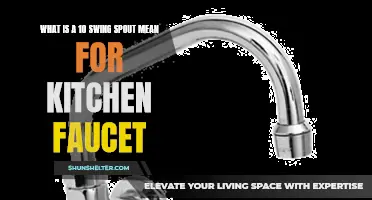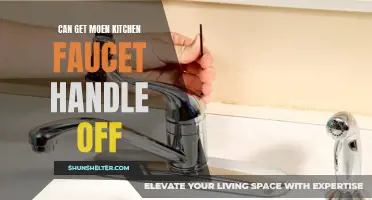
When it comes to installing a new kitchen faucet, one common concern is whether or not it will fit with the existing water supply lines. The good news is that most kitchen faucets are designed to fit standard water supply lines, meaning you won't have to worry about making any major modifications or purchasing any additional parts. However, it's always important to double-check the specifications and measurements of your faucet and water supply lines to ensure a proper fit. In this article, we will explore the compatibility of kitchen faucets with water supply lines and provide some tips for a smooth installation process. So, if you're considering updating your kitchen with a new faucet, read on to learn more about how to ensure a perfect fit.
What You'll Learn

Do all kitchen faucet fit water supply lines?

One important consideration when choosing a kitchen faucet is whether it will fit your existing water supply lines. While many faucets are designed to fit standard connections, there are several factors to keep in mind to ensure compatibility.
Factors to consider when choosing a kitchen faucet
When selecting a kitchen faucet, it's important to consider factors such as the size and type of water supply lines, the compatibility with existing plumbing, and the understanding of different types of water supply lines.
Size and type of water supply lines
The size and type of water supply lines in your kitchen will determine the type of faucet you can install. The most common sizes for supply lines are 3/8-inch and 1/2-inch. It's important to check the size of your existing supply lines before purchasing a new faucet to ensure a proper fit.
Compatibility with existing plumbing
Another factor to consider is the compatibility of the faucet with your existing plumbing. Some older homes may have non-standard connections or outdated plumbing systems that may require additional adaptors or converters to properly connect the faucet to the water supply lines. It's important to assess your existing plumbing and make note of any potential compatibility issues before purchasing a new faucet.
Understanding different types of water supply lines
There are two main types of water supply lines commonly used in kitchen faucets: standard copper supply lines and flexible braided supply lines.
Standard copper supply lines are rigid and require soldering or compression fittings for installation. They are less flexible but offer better durability and longevity.
Flexible braided supply lines, on the other hand, are made of stainless steel mesh and are more flexible. They often come pre-assembled with compression fittings, making installation easier. However, they may not be as durable as standard copper supply lines.
Common kitchen faucet connection sizes
Kitchen faucets typically come with three common connection sizes: 3/8-inch compression fittings, 1/2-inch compression fittings, and 1/2-inch NPT (National Pipe Thread) fittings.
3/8-inch compression fittings are typically used for supply lines with a 3/8-inch diameter. These fittings require a compression nut and ferrule to connect the faucet to the supply lines.
1/2-inch compression fittings are used for supply lines with a 1/2-inch diameter. They also require a compression nut and ferrule for installation.
1/2-inch NPT fittings are threaded fittings that screw directly onto the supply lines. These fittings are commonly used in older plumbing systems and may require adaptors or converters for compatibility.
Adapters and converters
If your faucet's connection size doesn't match your existing supply lines, you may need to use adapters or converters to make them compatible.
Adapters are used to connect different sizes of fittings. For example, if you have a 3/8-inch supply line and a faucet with a 1/2-inch connection, you can use a 3/8-inch to 1/2-inch adapter to make them compatible.
Converters, on the other hand, are used to convert between different types of fittings. For example, if you have a faucet with a 1/2-inch NPT connection but your supply lines have compression fittings, you can use a converter to convert from one connection type to another.
Using adapters for compatibility
When using adapters or converters, it's important to ensure a secure and leak-free connection. Tighten the fittings properly using an adjustable wrench or pliers, but be careful not to overtighten, as this can damage the fittings or cause leaks.
Converting from one connection type to another
If you need to convert from one connection type to another, such as from compression to NPT, it may be necessary to replace the entire supply line. Consult a professional plumber if you're unsure about the process or need assistance with the conversion.
In conclusion, not all kitchen faucets fit water supply lines. It's important to consider factors such as the size and type of supply lines, compatibility with existing plumbing, and understanding of different types of water supply lines. By properly assessing these factors, you can ensure a proper fit and a secure connection for your new kitchen faucet.
DIY: Create a Stylish Narrow Kitchen Island for Your Small Space
You may want to see also
Frequently asked questions
No, not all kitchen faucets fit water supply lines. The compatibility of a faucet with water supply lines depends on the type and size of the faucet's connections. It is important to check the specifications of the faucet and water supply lines to ensure they are compatible before purchasing or installing a new faucet.
The most common types of water supply lines used for kitchen faucets are braided stainless steel lines and copper lines. These lines are flexible, durable, and resistant to corrosion. They typically come in standard sizes and are compatible with most kitchen faucets.
It is possible to use existing water supply lines with a new kitchen faucet, but it is important to check the compatibility of the connections. If the existing lines use a different type or size of connection than the new faucet, adapters or new supply lines may be needed.
If the connectors of your kitchen faucet do not match your water supply lines, you have a few options. You can look for adapters that can bridge the gap between the different types or sizes of connections. Alternatively, you can replace your existing water supply lines with ones that have the compatible connectors for your faucet.
Yes, it is a good idea to hire a professional plumber to install a new kitchen faucet with water supply lines. A professional plumber has the expertise and knowledge to ensure that the installation is done correctly and safely. They can also help with any compatibility issues between the faucet and water supply lines.







